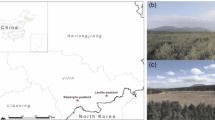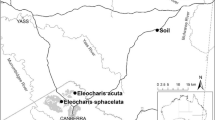Abstract
Burial depth within soil affects the survival of seeds and spores in ecosystems. However, burial depth effect on germinability of Sphagnum spores received little attention. In a peatland in Northeast China, we conducted a spore burial experiment using two hollow dwelling species, Sphagnum squarrosum and S. fallax. We hypothesised that i) S. squarrosum would show lower spore germinability than S. fallax because of its limited distribution in open area and ii) for both species there would be increased spore germinability along burial depth gradient because greater depth provides better conditions for spore preservation. After one-year spore burial, we conducted a laboratory germination bioassay to test spore germinability, determined by germination percentage (GP) and germination index (GI). Spore germinablity of S. squarrosum was >60% lower than S. fallax. Both species showed at least 40% higher germinability when buried in hollows than in hummocks. Overall spore germinability increased with burial depth with maximum germinability at 30 and 20 cm below the surface of hummocks and hollows respectively, where water table fluctuation occurred. We conclude that although hollows are better habitats for spore storage, continuous waterlogging may not be favourable for maintaining high germinability of Sphagnum spores.





Similar content being viewed by others
References
Atherton I, Bosanquet SDS, Lawley M (2010) Mosses and liverworts of Britain and Ireland: a field guide. British Bryological Society, UK, pp 276–311
Battle JM, Golladay SW (2001) Hydroperiod influence on breakdown of leaf litter in cypress-gum wetlands. The American Midland Naturalist 146(1):128–145
Bu ZJ, Hans J, Li HK, Zhao GL, Zheng XX, Ma JZ, Zeng J (2011) The response of peatlands to climate warming: a review. Acta Ecologica Sinica 31(3):157–162
Bu ZJ, Li Z, Liu LJ, Sundberg S, Feng YM, Yang YH, Liu S, Song X, Zhang XL (2017a) Bryophyte spore germinability is inhibited by peatland substrates. Acta Oecologica 78:34–40
Bu ZJ, Sundberg S, Feng L, Li HK, Zhao HY, Li HC (2017b) The methuselah of plant diaspores: Sphagnum spores can survive in nature for centuries. The New Phytologist 214:1398–1402
Cao T, Vitt DH (1986) Spore surface structure of Sphagnum. Nova Hedwigia 43(1–2):191–220
Clymo RS, Duckett JG (1986) Regeneration of Sphagnum. The New Phytologist 102(4):589–614
Clymo RS, Hayward PM (1982) The ecology of Sphagnum. Bryophyte Ecology. Springer, Netherlands, pp 229–289
Corstanje R, Reddy KR (2004) Response of biogeochemical indicators to a drawdown and subsequent reflood. Journal of Environmental Quality 33(6):2357–2366
Cronberg N (1993) Reproductive biology of Sphagnum. Lindbergia 17(4–6):69–82
Davis AS, Cardina J, Forcella F, Johnson GA, Kegode G, Lindquist JL, Luschei EC, Renner KA, Sprague CL, Williams MM (2005) Environmental factors affecting seed persistence of annual weeds across the US corn belt. Weed Science 53(6):860–868
del Rosario R-TM, Pérez-García B, Orozco-Segovia A (2004) Analysis of fern spore banks from the soil of three vegetation types in the central region of Mexico. American Journal of Botany 91(5):682–688
Dolinar N, Regvar M, Abram D, Gaberščik A (2016) Water-level fluctuations as a driver of Phragmites Australis primary productivity, litter decomposition, and fungal root colonisation in an intermittent wetland. Hydrobiologia 774(1):69–80
Duckett JG, Renzaglia KS (1993) The reproductive biology of the liverwort Blasia pusilla L. Journal of Bryology 17(4):541–552
Dyer AF, Lindsay S (1992) Soil spore banks of temperate ferns. American Fern Journal 82(3):89–123
Esteves LM, Dyer AF (2003) The vertical distributions of live and dead fern spores in the soil of a semi-natural woodland in Southeast Scotland and their implications for spore movement in the formation of soil spore banks. Pteridology in the New Millennium. Springer, Netherlands, pp 261–282
Gorham E (1990) Biotic impoverishment in northern peatlands. In: Woodwell GM (ed) The Earth in Transition: patterns and processes of biotic improverishment. Cambridge University Press, UK, pp 65–98
Hájek M, Roleček J, Cottenie K, Kintrová K, Horsák M, Poulíčková A, Hájková P, Fránková M, Dítě D (2011) Environmental and spatial controls of biotic assemblages in a discrete semi-terrestrial habitat: comparison of organisms with different dispersal abilities sampled in the same plots. Journal of Biogeography 38(9):1683–1693
Johnson LC, Damman AWH (1993) Decay and its regulation in Sphagnum peatlands. Advances in Bryology 5:249–296
Johnson MG, Shaw AJ (2015) Genetic diversity, sexual condition, and microhabitat preference determine mating patterns in Sphagnum (Sphagnaceae) peat-mosses. Biological Journal of the Linnean Society 115(1):96–113
Joosten H, Clarke D (2002) Wise use of mires and peatlands. International Mire Conservation Group and International Peat Society, Finland
Laiho R (2006) Decomposition in peatlands: reconciling seemingly contrasting results on the impacts of lowered water levels. Soil Biology and Biochemistry 38(8):2011–2024
Li W, Bu ZJ, Zhang BJ, Long C, Tang RJ, Cui QW (2013) Decomposition of Sphagnum litter in 4 Peatlands of the Changbai Mountains along an altitudinal gradient. Journal of Mountain Science 31(4):442–447
Limpens J, Tomassen HBM, Berendse F (2003) Expansion of Sphagnum fallax in bogs: striking the balance between N and P availability. Journal of Bryology 25(2):83–90
Ma JZ, Bu ZJ, Zheng XX, Ge JL, Wang SZ (2015) Effect of shading on relative competitive advantage of three species of Sphagnum. Mires and Peat 16(4):1–17
Miller SD, Nalewaja JD (1990) Influence of burial depth on wild oats (Avena fatua) seed longevity. Weed Technology 4(3):514–517
Moore PD, Bellamy DJ (1974) Peatlands. Elek Science, London
Moore TR, Bubier JL, Bledzki L (2007) Litter decomposition in temperate peatland ecosystems: the effect of substrate and site. Ecosystems 10(6):949–963
Noldin JA, Chandler JM, McCauley GN (2006) Seed longevity of red rice ecotypes buried in soil. Planta Daninha 24(4):611–620
Poschlod P (1995) Diaspore rain and diaspore bank in raised bogs and its implication for the restoration of peat mined sites. Restoration of Temperate Wetlands. John Wiley & Sons Ltd, UK, pp 471–494
Ranal MA (2003) Soil spore bank of ferns in a gallery forest of the Ecological Station of Panga, Uberlândia, MG, Brazil. American Fern Journal 93(3):97–115
Rudolph H, Kirchhoff M, Gliesmann S (1988) Sphagnum culture techniques. Methods in Bryology. The Hattori Botanical Laboratory, Nichinan, pp 25–34
Rydin H, Jeglum JK (2013) The biology of Peatlands, 2nd edn. Oxford University Press, UK
Santelmann MV (1992) Cellulose mass loss in ombrotrophic bogs of northeastern North America. Canadian Journal of Botany 70(12):2378–2383
Sundberg S (2002) Sporophyte production and spore dispersal phenology in Sphagnum: the importance of summer moisture and patch characteristics. Canadian Journal of Botany 80(5):543–556
Sundberg S, Rydin H (2000) Experimental evidence for a persistent spore bank in Sphagnum. The New Phytologist 148(1):105–116
Tan M, Liao F, Hou LT, Wang J, Wei LJ, Jian HJ, Xu XF, Li JN, Liu LZ (2017) Genome-wide association analysis of seed germination percentage and germination index in Brassica napus L. under salt and drought stresses. Euphytica 213(2):40
Van Zanten BO (1978) Experimental studies on trans-oceanic long-range dispersal of moss spores in the southern hemisphere. Journal of the Hattori Botanical Laboratory 44:455–482
Verhoeven JTA, Liefveld WM (1997) The ecological significance of organochemical compounds in Sphagnum. Acta Botanica Neerlandica 46(2):117–130
Acknowledgements
This study was funded by the National Key Research and Development Project (No. 2016YFA0602301), the Natural Science Foundation of China (No. 41571049, No. 41471043 and No. 41601085), the Scientific and Technological Developing Scheme of Jilin Province (No. 20140101163JC), Department of Human Resources and Social Security of Jilin Province and the Open Fund of the State Environmental Protection Key Laboratory of Wetland Ecology and Vegetation Restoration in Northeast Normal University (No. 130026516) and National Key Research and Development Program of China (No. 2016YFC0500407). Azim Mallik was partially supported by the Lecture Professor Program of the Northeast Normal University. We thank Xing-Lin Zhang for his help with the experimental materials preparation and Jin-Ze Ma and Jia-Li Ge for field assistance.
Author information
Authors and Affiliations
Corresponding authors
Rights and permissions
About this article
Cite this article
Feng, L., Bu, ZJ., Mallik, A. et al. Continuous Waterlogging May Not Facilitate Germinability Maintenance of Sphagnum Spores. Wetlands 37, 1015–1022 (2017). https://doi.org/10.1007/s13157-017-0936-y
Received:
Accepted:
Published:
Issue Date:
DOI: https://doi.org/10.1007/s13157-017-0936-y




